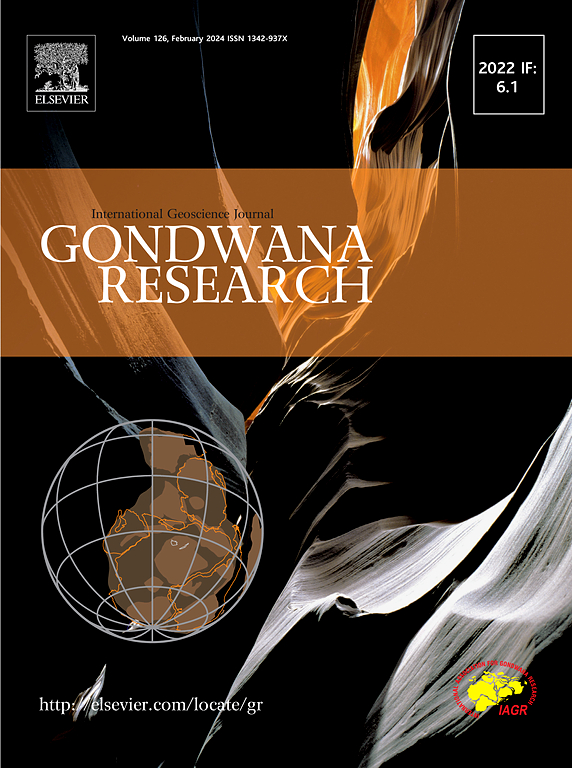Tectonostratigraphic framework of early-Cretaceous hydrocarbon-bearing deep-water architectures, divergent plate margins, NE-Arabian Sea: Spectral decomposition-based density-thickness-constraint lateral variability static reservoir simulations
IF 7.2
1区 地球科学
Q1 GEOSCIENCES, MULTIDISCIPLINARY
引用次数: 0
Abstract
Lowstands prograding wedges (LPWs) and basin floor fans (BFF) are the hottest areas for stratigraphic-based consortiums of hydrocarbon explorations. These stratigraphic traps are developed during the extensive fall of the sea, and subsequent, very slow rise inside the Lowstands system tract (LST). Hence, they mark the paleo-shelf-break and structure closure along the deep-water depositional systems (DWS). However, Pakistan exists on the verge of diverging plate boundaries, which have signified traverses of Horst and Grabens geological structures along normal faults. NW-SE aligned wrench faults, local-to-regional scale transverse fractures, and together with intensely fluctuating NE-Arabian rising sea levels have collectively constrained the development of tectonostratigraphic architecture throughout slope-to-basin floor patterns. Subsequently, the full spectrum seismic amplitude-based volumes (FSM) generate ambiguities in the quantitative prediction of DWS. This research utilizes the broadband prompt spectrum waveform-originated thickness and density-controlled inverted velocities and density basin simulations (TDVDRS) of the Cretaceous system, NE-Arabian Sea. However, these FSM attributes failed to image the laterally continuous and possible gas-bearing sediments due to a poorly resolved thickness of 6 m. This thickness was below the tuning thickness threshold of 14 m for this source-hydrocarbon play. The TDVDRS have predicted 15 m thick aggradational parasequences of the top seal, 13 m thick progradational-to-retrogradational lateral seal, and 12 m thick progradational shale of bottom sealing configurations. An angular unconformity was resolved at the top of Horst and Grabens structure at depths of 3240–3270 m and pseudo-thickening [PT] [m]: pseudo-density [gm. /c.c.] [PD] of 11–23-m: ∼2.05–2.25 gm. /c.c during falling sea-level. This process has replaced the younger erosional sediments at the compacted bottom and adjacent seal configurations. This workflow has strong tectonostratigraphic implications for diverging the NE-Arabian Sea, which may serve as an analogue for developing the world’s gigantic divergent plate margins.

东北-阿拉伯海早白垩世含油气深水构造地层格架:基于谱分解的密度-厚度约束侧向变率静态储层模拟
低水位推进楔(LPWs)和盆地底扇(BFF)是地层学油气勘探的热点区域。这些地层圈闭是在低洼体系域(LST)内广泛的海水下降和随后的缓慢上升过程中形成的。因此,它们标志着深水沉积体系(DWS)的古陆架断裂和构造闭合。然而,巴基斯坦处于板块边界发散的边缘,这表明了沿正断层的地堑和地堑地质构造的穿越。NW-SE向的扳手断裂、局地尺度的横向断裂以及强烈波动的NE-Arabian海平面上升共同制约了整个坡-盆底构造地层结构的发展。随后,基于地震振幅的全谱体积(FSM)在DWS的定量预测中产生了模糊性。本研究利用了东北阿拉伯海白垩纪体系的宽带提示频谱厚度和密度控制反演速度和密度盆地模拟(TDVDRS)。然而,由于6 m厚度的分辨率较差,这些FSM属性无法对横向连续的可能含气的沉积物进行成像。该厚度低于该烃源区调优厚度阈值14 m。TDVDRS预测了15 m厚的顶封沉积准层序、13 m厚的进积—退积侧向密封和12 m厚的底封进积页岩构型。在3240 ~ 3270 m深的地堑和地堑构造顶部解出了角不整合,伪增厚[PT] [m]:伪密度[gm. /c.c。[PD]在海平面下降期间为11 - 23 m: ~ 2.05-2.25 gm. /c.c。这一过程取代了压实底部和邻近密封构造中较年轻的侵蚀沉积物。这一工作流程对东阿拉伯海的分流具有很强的构造地层学意义,它可以作为发展世界上巨大的发散板块边缘的类比。
本文章由计算机程序翻译,如有差异,请以英文原文为准。
求助全文
约1分钟内获得全文
求助全文
来源期刊

Gondwana Research
地学-地球科学综合
CiteScore
12.90
自引率
6.60%
发文量
298
审稿时长
65 days
期刊介绍:
Gondwana Research (GR) is an International Journal aimed to promote high quality research publications on all topics related to solid Earth, particularly with reference to the origin and evolution of continents, continental assemblies and their resources. GR is an "all earth science" journal with no restrictions on geological time, terrane or theme and covers a wide spectrum of topics in geosciences such as geology, geomorphology, palaeontology, structure, petrology, geochemistry, stable isotopes, geochronology, economic geology, exploration geology, engineering geology, geophysics, and environmental geology among other themes, and provides an appropriate forum to integrate studies from different disciplines and different terrains. In addition to regular articles and thematic issues, the journal invites high profile state-of-the-art reviews on thrust area topics for its column, ''GR FOCUS''. Focus articles include short biographies and photographs of the authors. Short articles (within ten printed pages) for rapid publication reporting important discoveries or innovative models of global interest will be considered under the category ''GR LETTERS''.
 求助内容:
求助内容: 应助结果提醒方式:
应助结果提醒方式:


